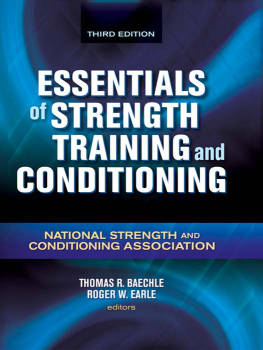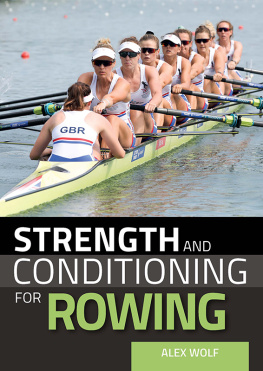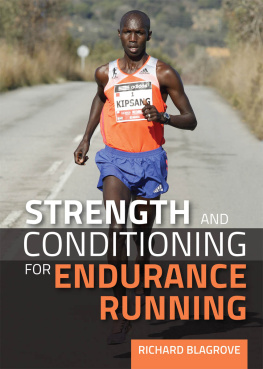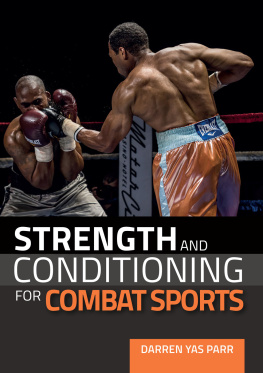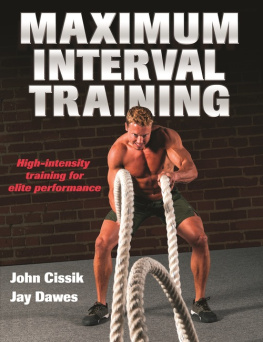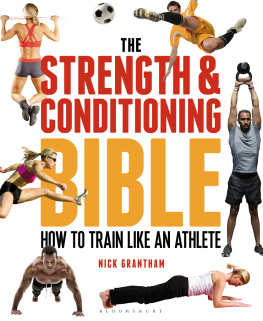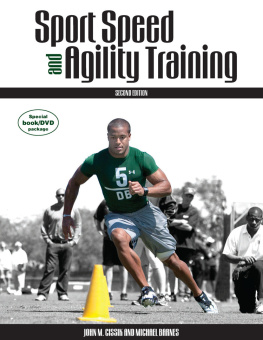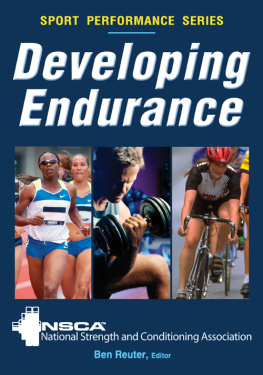Cissik - The Coaches’ Strength and Conditioning Training Toolkit
Here you can read online Cissik - The Coaches’ Strength and Conditioning Training Toolkit full text of the book (entire story) in english for free. Download pdf and epub, get meaning, cover and reviews about this ebook. year: 2016, publisher: Coaches Choice, genre: Romance novel. Description of the work, (preface) as well as reviews are available. Best literature library LitArk.com created for fans of good reading and offers a wide selection of genres:
Romance novel
Science fiction
Adventure
Detective
Science
History
Home and family
Prose
Art
Politics
Computer
Non-fiction
Religion
Business
Children
Humor
Choose a favorite category and find really read worthwhile books. Enjoy immersion in the world of imagination, feel the emotions of the characters or learn something new for yourself, make an fascinating discovery.

- Book:The Coaches’ Strength and Conditioning Training Toolkit
- Author:
- Publisher:Coaches Choice
- Genre:
- Year:2016
- Rating:5 / 5
- Favourites:Add to favourites
- Your mark:
- 100
- 1
- 2
- 3
- 4
- 5
The Coaches’ Strength and Conditioning Training Toolkit: summary, description and annotation
We offer to read an annotation, description, summary or preface (depends on what the author of the book "The Coaches’ Strength and Conditioning Training Toolkit" wrote himself). If you haven't found the necessary information about the book — write in the comments, we will try to find it.
Cissik: author's other books
Who wrote The Coaches’ Strength and Conditioning Training Toolkit? Find out the surname, the name of the author of the book and a list of all author's works by series.
The Coaches’ Strength and Conditioning Training Toolkit — read online for free the complete book (whole text) full work
Below is the text of the book, divided by pages. System saving the place of the last page read, allows you to conveniently read the book "The Coaches’ Strength and Conditioning Training Toolkit" online for free, without having to search again every time where you left off. Put a bookmark, and you can go to the page where you finished reading at any time.
Font size:
Interval:
Bookmark:

John Cissik

2015 Coaches Choice. All rights reserved. Printed in the United States.
No part of this book may be reproduced, stored in a retrieval system or transmitted, in any form or by any means, electronic, mechanical, photocopying, recording, or otherwise, without the prior permission of Coaches Choice. Throughout this book, the masculine shall be deemed to include the feminine and vice versa.
ISBN: 978-1-60679-317-6
Library of Congress Control Number: 2014948875
Book layout: Cheery Sugabo
Cover design: Cheery Sugabo
Front cover photos: iStock/Thinkstock
Text photos: Chuck Shanlever
Illustrations: Vyacheslav Biryukov/iStock/Thinkstock (Chapter 4); vizualbyte/iStock/Thinkstock (Chapter 9)
Coaches Choice
P.O. Box 1828
Monterey, CA 93942
www.coacheschoice.com
Acknowledgments
A number of people help to make a book like this possible. I would like to thank my wife Ewa and my kids Hektor, Marcus, and Duncan for the patience and support during this process. Kristi Huelsing and Jim Peterson from Coaches Choice were a pleasure to work with again, always communicating clearly what the expectations are, and making this process as painless as possible.
I would also really like to thank the models in this book. Taking photos of exercise technique is an interesting experience. No matter how much weight is being used, holding these positions while the camera adjusts can be a challenging experience for even the fittest person. Even with modern digital photography, this can still be a lengthy process, especially with the 150 photos that are in this book. Jordan Karnes and Tinesha Bustos were all very patient during this process, and their help was invaluable.
Finally, I would like to thank Texas Womans University for the use of their Fitness and Recreation Center during the shooting of the photographs in this book.
Introduction
Strength and conditioning has been an emerging field over the last 30 years. Over this time period, it has been regarded as indispensable for the preparation of athletes. Strength and conditioning improves performance, prevents injuries, and is used to help rehabilitate injuries.
The coaching of strength and conditioning is part science and part art. The science has established a foundation concerning how exercise works and what it does. However, the science has not yet effectively established the most optimal ways of applying strength and conditioning. This is where the art of coaching comes in. The coach must try new things, assess their effectiveness, and remain flexible in the conditioning of their athletes.
Over the last 30 years, the field of strength and conditioning has changed radically, and the expectations placed upon its coaches have also changed. Thirty years ago, strength and conditioning meant a weight room dominated activity primarily focused around the Olympic lifts and the bench press, squat, and deadlift. Today, that is still a part of strength and conditioning; indeed, it still makes up the foundation of the weight room work. However, today a strength coach is expected to understand the use of other implements such as kettlebells, heavy ropes, suspension training, and sandbags. In addition, there is an expectation to apply strength and conditioning to the sport via speed training, agility training, and plyometrics. In other words, the toolkit for a strength and conditioning coach has expanded greatly over the last 30 years.
Accompanying the expansion in the tools that a strength and conditioning coach can use is a great degree of marketing about each tool. This is not surprising; marketing alerts the coach to the existence of the tool and seeks to convince a coach that a tool is needed. This is usually by attempting to make a new tool seem to be the best strength and conditioning tool and to establish that it is better than the others. As very little research is available on the newer strength and conditioning tools, this is largely done via testimonials. For example, Athlete X uses this tool or Coach Y advocates its use. With the expansion in social media over the last few years, marketing has become even easier.
The challenge to any coach is to filter through all this information. No matter the level at which an athlete competes, athletes have a very limited amount of time to train. Athletes also have a limited ability to recover from training. These two facts are further complicated by the fact that strength and conditioning has to complement and support the athletes sports training. This means that any training tool that is selected, any exercise that is included in an athletes program, has to make the best possible use of the athletes limited time and recovery ability. This is a challenge given the noise surrounding most of the training tools and their approaches.
It is the intent of this book to introduce the coach to the various training tools that are employed today. This will include traditional exercises like the squat and the power clean as well as newer exercises like sandbags. After introducing the tools, this book will provide a framework to help the coach make decisions about which tools to employ and how to use them.
This book is organized into three parts. The first part provides the background to strength and conditioningwhy its used, what it does, how to use it effectively, and how to employ it safely. The second part provides an overview to the various training tools (free weights, kettlebells, suspension trainers, heavy ropes, sandbags, and speed/agility/plyometric exercises). Exercises are described and extensively illustrated. The final part covers how to incorporate these tools into an effective training program.
This book is primarily geared toward the sports coach and to the athlete that is a consumer of strength and conditioning. Hopefully, this book provides some perspective and helps the reader wade through the marketing, hype, and testimonials. Many of the tools described in this book are extremely effective, but there is no best. There is only best for specific situations, and understanding that will help to maximize the athletes training time.
Part I Background
Part I of this book is meant to provide the background behind the strength and conditioning of athletes. It provides an overview of the hows and whys behind using strength and conditioning. Its divided into three chapters: the first deals with why people train, the second deals with principles of training, and the third deals with safety.
The first chapter describes the benefits that athletes receive from training. Understanding these benefits is important for the coach. These benefits are the motivation behind incorporating strength and conditioning into a program. Benefits may include changing the athletes body, improving performance, or preventing or rehabilitating injuries.
The second chapter provides the foundational principles that underlie successful strength and conditioning programs. These principles make strength and conditioning a deliberate, focused, and successful process that addresses an athletes needs. Failing to apply these principles means that any performance improvement is by chance and may not use the athletes limited time well.
The third chapter is important for keeping training a safe and effective process. Clearly, athletes should not be injured while performing strength and conditioning. This chapter discusses how to warm up to prevent injuries, how to understand the difference between being sore and being hurt, and how to stay safe in the strength and conditioning environment.
Next pageFont size:
Interval:
Bookmark:
Similar books «The Coaches’ Strength and Conditioning Training Toolkit»
Look at similar books to The Coaches’ Strength and Conditioning Training Toolkit. We have selected literature similar in name and meaning in the hope of providing readers with more options to find new, interesting, not yet read works.
Discussion, reviews of the book The Coaches’ Strength and Conditioning Training Toolkit and just readers' own opinions. Leave your comments, write what you think about the work, its meaning or the main characters. Specify what exactly you liked and what you didn't like, and why you think so.

